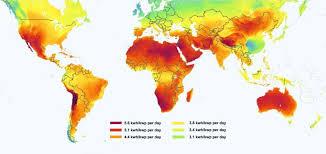How Many Solar Sun Hours Does Your State Really Get?

Alex stood in his backyard one warm afternoon, staring at his rising electricity bill and wondering if solar could finally bring relief. But before choosing a system size or panel brand, his installer asked the most important question: How Many Solar Sun Hours Does Your State Really Get?
That single question sent Alex down a rabbit hole, discovering that not every sunny day translates into usable solar energy—and that the number of “sun hours” in his state would ultimately determine whether solar saved him a little…or a whole lot.
Understanding What Solar Sun Hours Mean
Solar sun hours are not the same as daylight hours. Instead, they represent how many hours per day sunlight is strong enough to produce 1,000 watts per square meter—also called “peak sun hours.”
This measurement matters because it defines how efficiently your solar panels will perform in your exact location.
Why Peak Sun Hours Matter
· They determine the number of panels you need.
· They shape your solar system’s total output.
· They help installers properly size your battery and inverter.
· They influence your payback period and long-term savings.
Even states with cloudy weather can get good solar performance—if their peak sun hours are consistent and predictable.
U.S. States With the Most Sun Hours
Some regions of the country have unusually high solar potential due to clear skies, dry air, and large stretches of desert terrain.
Top High-Sunlight Regions
· Southwest: Arizona, Nevada, New Mexico
· West: California, Colorado, Utah
· South: Texas, Florida
Arizona often leads the nation with 7+ average peak sun hours per day, making it one of the best states for solar returns.
States With Moderate Solar Sun Hours
Not every state is a desert, but many still provide surprisingly strong solar productivity.
Moderate-Sun Regions
· Georgia
· Virginia
· North Carolina
· Tennessee
· Oklahoma
· Missouri
These states often average 4–5.5 daily peak sun hours—more than enough for cost-effective home solar.
Low Sun Hour States Still Benefit
States with more clouds, rain, or northern latitude still benefit from solar installations, often thanks to strong incentives and modern panel efficiency.
States With Lower Averages
· Washington
· Oregon
· Ohio
· Michigan
· New York
· Pennsylvania
Most of these states average 3–4.2 peak sun hours, yet homeowners still cut bills significantly because solar systems are designed to compensate for lower annual sunlight.
What Impacts Sun Hour Levels?
The number of usable sun hours in your state depends on multiple factors.
Key Influencing Factors
· Latitude: Northern states receive sunlight at a lower angle.
· Seasonality: Winter naturally reduces daily sun hours.
· Weather Patterns: Cloudy or coastal climates reduce solar intensity.
· Air Quality: Dust, smoke, and humidity can diffuse sunlight.
· Altitude: Higher elevations often receive stronger sunlight.
Solar Panel Performance by State
Even if your state receives fewer peak sun hours, modern solar panels are designed to perform in diverse climates.
Technology Making a Difference
· High-efficiency monocrystalline panels
· Bifacial panels that capture reflected light
· Microinverters that maximize output in shade
· Smart monitoring systems enhancing daily performance
Your exact system output depends on combining your state’s sun hours with the right technology.
MAP: Average Solar Sun Hours by Region
Below is a simplified map-style breakdown of regional solar potential.
Southwest Region (6–7.5 Hours/Day)
· Arizona
· Nevada
· New Mexico
West Region (5–7 Hours/Day)
· California
· Utah
· Colorado
South Region (4.5–6 Hours/Day)
· Texas
· Florida
· Georgia
Midwest Region (3.5–5 Hours/Day)
· Illinois
· Missouri
· Kansas
Northeast Region (3–4.5 Hours/Day)
· New York
· Pennsylvania
· Massachusetts
MAP: Seasonal Changes in Sun Hours
Seasons significantly shift how many peak sun hours your system gets.
Summer (High Solar Output)
Most states gain 1–3 additional peak sun hours due to longer days and higher solar angles.
Winter (Low Solar Output)
Northern states lose 1–2 sun hours, particularly in December and January.
Spring & Fall (Moderate Output)
Shoulder seasons offer balanced production and mild weather benefits.
Calculate Your State’s Exact Sun Hours
The best way to understand your home’s solar potential is to use tools designed for precise sunlight calculations.
Useful Tools
· NREL PVWatts
· Solar Resource Maps
· Satellite-based sunlight calculators
· Local installer assessments
These tools combine your location, tilt angle, roof direction, and shading analysis to deliver accurate sunlight data.
Matching Panel Size to Sun Hours
Once you know your state’s sunlight average, you can determine the correct system size.
General System Size Guidelines
· High-sun states: Fewer panels needed for desired output
· Medium-sun states: Standard residential sizing recommended
· Low-sun states: Larger system size or higher-efficiency panels
This step ensures your installation is cost-effective and aligned with your daily usage.
Real Homeowner Example
When Alex finally calculated his sunlight hours—4.9 per day—he discovered he didn’t need as many panels as he feared.
His installer explained that his region’s consistent year-round sunlight made solar a strong investment. That clarity helped Alex move forward confidently, knowing his system would perform reliably.
And that’s when he finally understood why experts keep asking: How Many Solar Sun Hours Does Your State Really Get?
Conclusion
Your solar savings aren’t determined by your zip code alone—but by the exact number of usable sun hours your location receives daily. By understanding How Many Solar Sun Hours Does Your State Really Get?, you can size your system properly, forecast your energy savings, and make a well-informed investment.
Whether you live in a high-sun state like Arizona or a cloudier region in the Northeast, solar can still work for you—as long as it's designed with your state’s sunlight in mind.
- Creative Multimedia
- Education & Innovation
- Business & Technology
- Sustainability & Ethics
- App & IT Development
- Community & Culture
- Thought Leadership
- Event
- AI & Robotics
- Craft
- Movie
- Fitness
- Free Peck
- Game
- Tutorial
- Health
- Music
- Networking
- Other
- Business
- Religion
- Shop
- Sport
- Wellbeing



